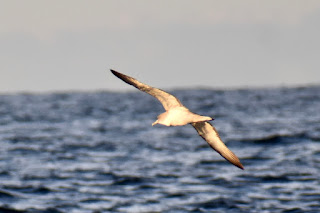Tuna(less) Fishing Trip 8/14/22
This past weekend my friend, Captain John, invited me on another fishing trip for tuna. Based on the successful trip we had two weeks ago; I was excited for another day out on the ocean. The offshore weather forecast for Sunday called for light winds and two-foot seas meant a smooth and quicker ride. The fishing reports indicated that schools of larger yellowfin tuna, in the 80-pound range, and bigeye tuna, which run twice that size, had moved into the area. The weather forecast, the fishing reports and my own hopes of seeing some summer pelagic birds, had my anticipation levels heightened.
We left the dock by 1:30 a.m. and headed northeast out of Barnegat Inlet. We arrived at the fishing grounds just before sunrise and the seas were light as had been forecasted. However, we would spend about the next six hours searching for tuna. The closest thing we caught was a false albacore. False albacores are not considered tasty. It is different than albacore, or longfin tuna, which is what comes in the cans of tuna you would buy at the food store. The big sushi class tuna we hoped to catch were elusive. There was other marine life around the fishing grounds that included several humpback whales, schools of fast-moving dolphin, Wilson’s storm-petrels, great shearwaters and at least one Cory’s shearwater.
With midday approaching, the captain decided to change venues. We headed over to the nearby Hudson Canyon fishing area. The captain hoped that trolling the deeper water might produce a bigeye tuna. I also hoped the deeper water might produce a jaeger, a black-capped petrel, maybe a sooty or bridled tern, or even better, a white-faced storm-petrel. Unfortunately, no tuna and the only birds were more Wilson’s storm-petrels and great shearwaters. Even though the tuna got the better of us, Captain John would not give up on catching fish. We moved to another spot where the water depth ranged between 450 to 600 or so feet. We were switching to bottom fishing for golden tilefish. Finally, our luck changed, and everyone on board caught his share of bulky tilefish before we had to make the approximate four-hour ride towards home.
I first caught tilefish last year in the same spot with Captain John. It was also the first time I ate tilefish. Delicious is an understatement. In my opinion the taste is more like crab or lobster than fish. It instantly became a favorite for my wife and me. While fishing for the tiles, I had an unexpected sighting briefly fly by us - a bat! Yes, out on the North Atlantic Ocean, a bat fluttered over us. Of course, since I was actively fishing, I had put my camera safely inside the cabin. I do not know if I would have gotten a recognizable picture of it even if I had my camera handy. It was gone within seconds and never reappeared. My guess is that it was an eastern red bat. I saw one last fall on a whale watching boat out of Cape May, NJ, but that was much closer to shore, maybe a mile or two from the beach. Red bats are a species found in New Jersey and I read up on them after that sighting. I learned that they migrate along the same route as birds along the Atlantic seaboard and have been noted in daytime migration.
You never know what you might see out on the ocean, and you’ll never see anything if you don’t go.









Comments
Post a Comment